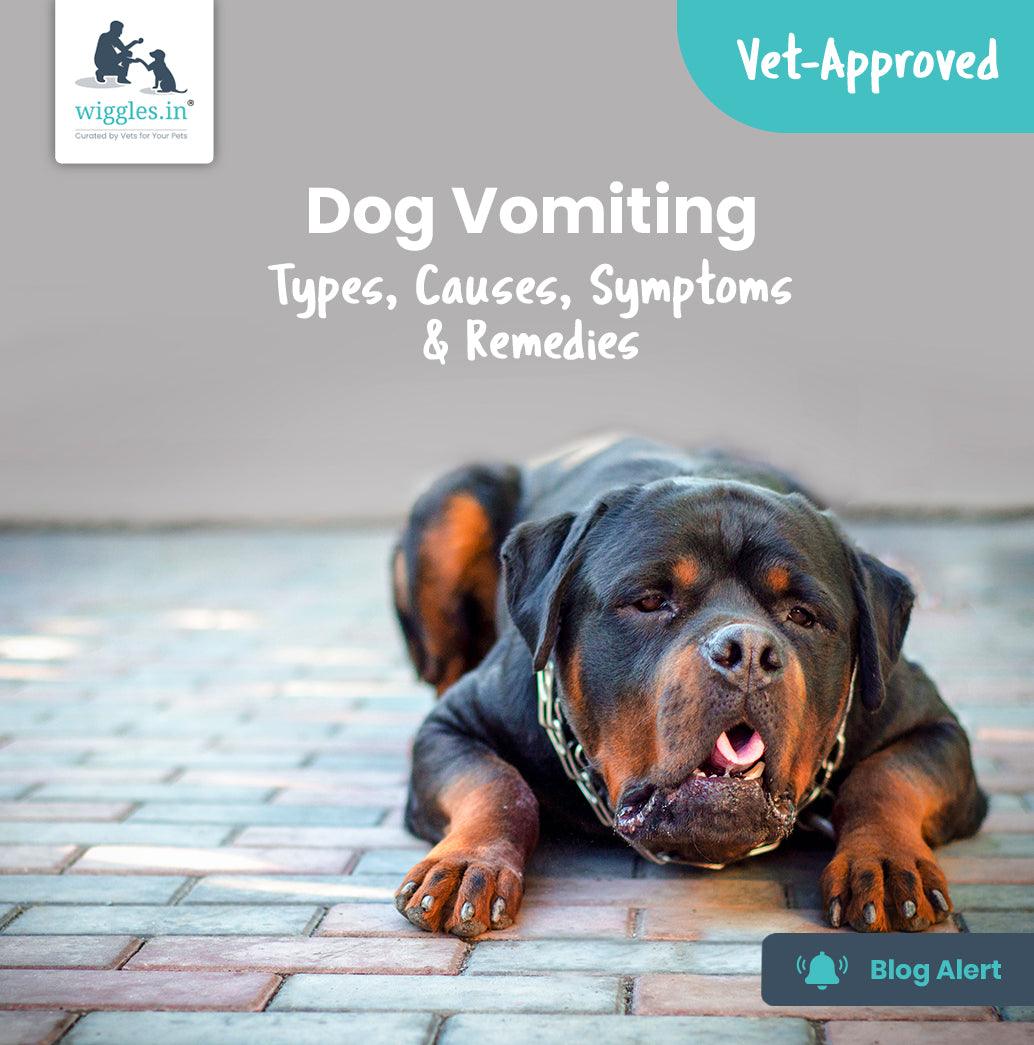Being a dog parent is mostly a smooth ride until your dog vomits & you have got no clue. Your mind is flooded with questions. You seek information from the internet but sometimes it’s just not enough. Watching your dog struggle with vomit is probably the most harrowing experience one can have as a pet parent. The feeling of helplessness takes over & panic sets in. We understand this situation & that’s why our in-house veterinarians have compiled everything you need to know on dog vomit!
Why do dogs vomit?
Dogs vomit or puke for multiple reasons. Vomiting is nothing but your dog trying to forcefully eject items from the stomach & intestine. These items can be undigested food, fluids, bile or anything that wasn’t supposed to be swallowed. Dog vomiting is often preceded by symptoms like nausea, excessive drooling, retching or contractions of the abdomen. In some cases, dogs also eat grass to induce vomiting.
So if you see any of the above-mentioned signs, be quick on your feet. Grab a plastic bag or help your dog off the bed or the carpet to a place where they can vomit.
Vomiting is not a pleasant experience for anyone but in order to determine the cause, it is important to take note of the color, content, smell (like sour or foul), presence of any worms, consistency etc. If possible, click a picture of the vomit. It will be easier for the veterinarian to identify the cause & suggest the right course of treatment.
Type & color of the vomit
Believe it or not, the type & color of vomit goes a long way in determining the cause.
Yellow vomit
If your dog’s vomit is yellow-colored, don’t worry. It is quite common in dogs and happens because of bile secretions. Other reasons behind it are acid buildup & reflux. It can also happen on an empty stomach.
As per our in-house veterinarians, it mostly occurs either early in the morning or late at night. So if your dog is vomiting yellow-colored bile in these hours, keep calm & administer an antacid for instant relief.
White foamy vomit
White-colored vomit is also a result of acid reflux in the stomach. The color change is mainly due to the air inside the stomach that comes into contact with the vomit just before it’s ejected out of the system.
Clear liquid vomit
A clear liquid vomit results from an upset stomach or due to water consumption while your dog was feeling nauseous.
Bloody vomit (red or pink)
If there is blood in the vomit, it’s a sign of urgency. This is an indication that something is wrong with the intestines. There can be blood clotting, ulcer, tumor, or even poisoning and such a situation demands immediate medical help. Do not delay & rush your dog to your veterinarian.
Brown or mustard-colored vomit
Brown vomit is nothing but food that never reaches the stomach. This happens when your dog eats in a rush, forgets to chew & swallows the food as is. When this happens, your dog also ends up swallowing a lot of air.
This is not a worrisome situation. But keep an eye on any traces of blood. If you find blood, it’s a sign to visit your veterinarian as soon as possible.
Mucus & slimy vomit
Mucus-like, slimy vomit happens when your dog is drooling excessively due to a possible irritation in the stomach. It pools inside the stomach and is then ejected out of the body in the form of vomit.
Green-colored vomit
Green-colored vomit often happens due to consuming grass. It’s common for dogs to graze if they are experiencing an upset stomach. It is known to help them induce vomiting.
Worms in vomit
If you notice any worms, alive or dead, it is a sign of worm infestation in the gut. Worms like roundworms & tapeworms can find their way into your dog’s digestive system. They lay eggs, feed on your dog’s blood & prevent them from digesting food.
If you have noticed worms in your dog’s vomit, it’s better to take your veterinarian’s advice & follow your dog’s deworming schedule regularly.
Home remedies for vomiting
Before relying on home remedies, it’s important to identify the color of the vomit. Some cases require urgent medical attention. In such cases, home remedies should not be resorted to. If your dog is experiencing continuous vomiting and is visibly pale and lethargic, please visit your nearest veterinarian.
- Vomiting can cause dehydration. Once your dog has vomited the undigested food and bile, pour some fresh water for them to drink. If you have access to electrolytes like ORS, please mix well and serve it to them. And if you don’t, you can simply make a solution at home!
- If your dog has vomited, don’t introduce any food for some time. A puppy should not be fed for around 12 hours, an adult dog can be put on fast for almost a day. This will provide some relief to the digestive system.
- After the fasting period, serve food like boiled rice mixed with curd to ease the digestion process. Homemade curd is chock-full of good bacteria known as probiotics. While rice will be easier to digest, the curd will calm down the digestive system & provide nourishment in the form of good bacteria to the gut.
- Veterinarians prescribe antiemetics in case of vomiting but if you don’t have one, you can try ginger as a remedy. It is known to have antiemetic effects. Boil a piece of ginger in water, let it cool & serve 2-3 tablespoons of that ginger water to your dog. This will provide relief by blocking the serotonin receptors in the gut that causes dogs to feel nauseous.
Our veterinarians suggest that as pet parents, you should always be equipped with a basic emergency care kit that can come to your rescue in such emergencies. An emergency care kit contains all the basic medications (for vomiting, dehydration, allergies etc) and equipment (scissors, cotton, betadine, ointment etc) needed. Since an emergency care kit comes with a care guide, you don’t have to worry about the dosage and directions either!
When to see a veterinarian?
A visit to the veterinarian is a must if -
- Vomiting is continuous and isn’t stopping even after providing first aid relief
- There’s blood in the vomit
- Vomiting has caused dehydration (look for symptoms like lethargy, weakness, inability to perform basic activities like walking etc)
How to prevent vomiting?
Unfortunately, there are no set ways in which vomiting can be prevented although some precautions can be taken -
- If it is extremely hot, make sure you don’t feed food that’s difficult to digest. Opt for bland food or curd mixed with boiled rice at least once a day.
- Regular deworming is another ideal way to prevent worm induced vomit
- Don’t leave or skip out on your dog’s meal. This can lead to acid reflux causing your dog to throw up yellow bile.
- If you are traveling with your dog, prepare accordingly. To know more about how to prevent motion sickness & vomiting during a car ride, head to our blog here.
- And the easiest way to prevent vomiting & an upset stomach is a regular intake of probiotics. Instead of going back to your regular pills, transition to fast-acting probiotic strips that will melt within seconds! Each strip of Stripzy™ contains 5 Billion CFUs & is infused with herbs like Brahmi & Ashwagandha.
Our pets mean the world to us, let’s make sure we protect our world by being the best pet parents possible! Also, we are always here to walk you through the journey of pethood. If you have any questions, please feel free to contact us on +91 8431620000.



















